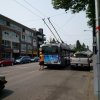CodeMonkey
Active Member
The new trolleybuses can run on batteries, flywheels, or Primove. The old trolleybuses needed a garage (Lansdowne & Eglinton) to be right beside a trolleybus line. The new trolleybuses don't, so existing or new garages don't have to be. Just need an electrical supply to recharge them.
The TTC isn't going to spend the money on an entirely new system that either relies on running in the downtown using the existing overhead streetcar power or an underground system that is still relatively new. With TTC still pushing out what remains of TransitCity, the financial black hole that is commonly refer to as the Scarborough Subway Extension, and John Tory Smart Track pet project. I doubt you'll see any funding or interest in bringing back trolleybuses anytime soon.





